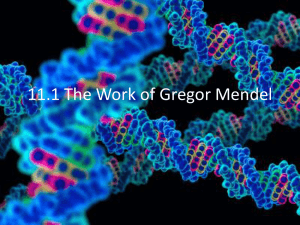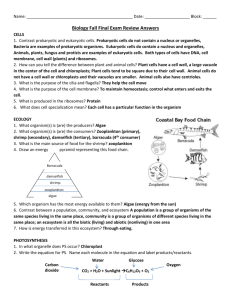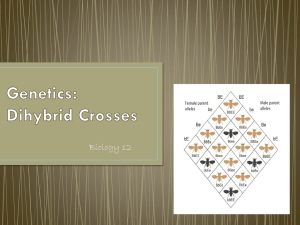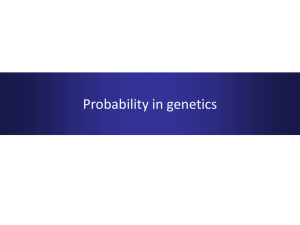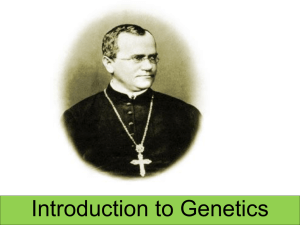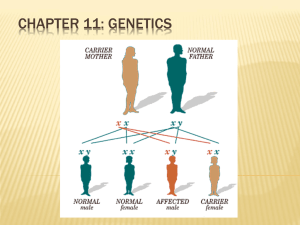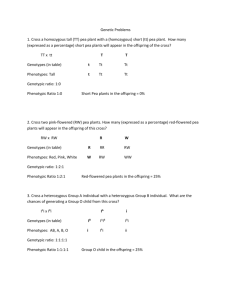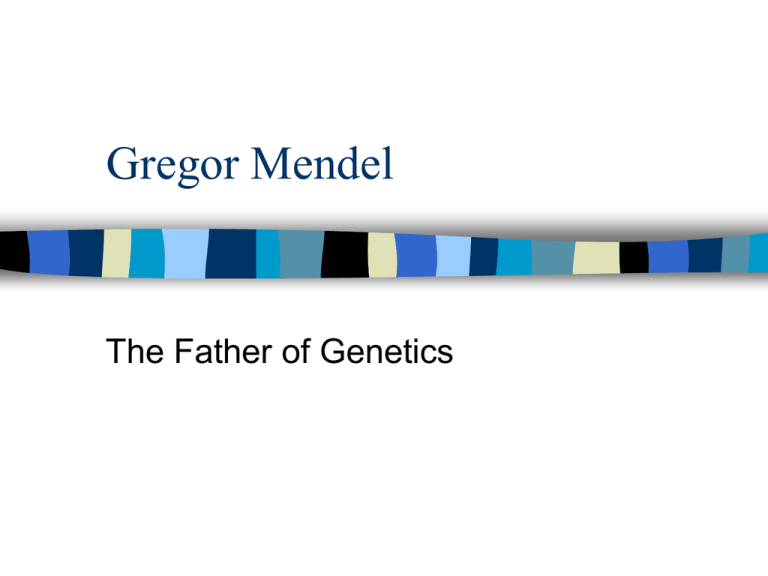
Gregor Mendel
The Father of Genetics
Mendel
Modern genetics had its beginnings in
an abbey garden, where a monk named
Gregor Mendel documented a particular
mechanism of inheritance.
He discovered the basic principles of
heredity by breeding garden peas in
carefully planned experiments.
Why peas?
Peas are normally self-pollinating.
Peas are easily grown,
Peas mature quickly
Peas produce many seeds
Peas show several pairs of obvious
contrasting traits
The use of plants also allowed strict
control over the mating.
Pea’s contrasting traits
Tall plant vs. dwarf plant
Yellow seeds vs. green seeds
Smooth seeds vs. wrinkled seeds
Inflated pod vs. constricted pod
Purple flower vs. white flower
Green pod vs. yellow pod
Axial flower vs. terminal flower
Mendel experiments
Mendel spent several
years self-pollinating
the pea plants in order
to establish purebred
plants.
Mendel’s experiments
These pure-breeding plants were called
the P generation.
Mendel had strains of peas that were
pure breeding for height: the plants
were either tall or dwarf
He had strains that had either yellow
pods or green pods, inflated pods or
constricted pods.
Mendel’s experiments
When a pure breeding tall plant is
crossed with a pure breeding dwarf
plant, all the resulting plants are called
hybrids.
All the hybrids are called the F1
generation ( first filial generation)
All of the F1 generation were tall
Mendel’s experiment
The same pattern was observed in each
of the 7 contrasting characteristics.
In the F1 generation, all of the plants
showed one characteristic.
Mendel called this characteristic the
dominant trait
The trait that was not expressed in F1
was called the recessive trait
Mendel’s experiment
Next, Mendel crossed the F1 generation
plants.
He wanted to know if the F1 plants were
identical to the P generation
So he crossed two of the F1 plants
Mendel’s experiment
The resulting plants (the F2 generation)
yielded 3 tall plants and 1 dwarf plant.
A ratio of 3:1
Mendel’s experiment
This meant that the tall F1 plants ( the
hybrids) were different than the tall P
generation plants (the purebred plants)
even though they were all tall.
Mendel’s experiment
Mendel repeated this experiment with
all of the traits and the results were
similar.
The F2 generation displayed a
phenotypic ratio of 3:1
Mendel’s explanation
Units of inheritance, called factors (we
now call them genes) were involved
For any given characteristic there were
several different forms (now called
alleles)
Each plants phenotype (what they look
like) was determined by a pair of alleles
that can be identical or different
Mendel’s explanation
In a hybrid plant one allele of a pair has
the ability to express itself while the
other one is not expressed.
Recessive characteristics are
expressed only when there is no
dominant allele present
Mendel’s explanation
When gametes are produced, the
members of each pair of alleles are
separated into different reproductive
cells.
A gamete can contain only one allele of
a particular characteristic.
When fertilization occurs these alleles
unite to give the zygote the necessary
pair of alleles.
Mendel’s first law
The Law of Segregation
Members of a pair of alleles for a given
trait are segregated when gametes are
formed
Genotype
The genotype represents the genes that
exist in the organism
Mendel used letters of the alphabet to
represent genes.
Capital letters represent the dominant
allele
Lower case letters represent the
recessive allele
Genotype
A purebred tall plant would have a
genotype of TT
A purebred dwarf plant would have a
genotype of tt
Genotypes with identical alleles are
called homozygous
Genotypes with different alleles are
called heterozygous
The sex cells of a TT plant would
contain only the dominant allele T
The sex cells of a tt plant would contain
only the recessive allele t
The F1 generation would all have the
genotype Tt
The phenotype of all the F1 generation
would be tall
Mendel’s impact
Mendel’s theories of inheritance, first
discovered in garden peas, are equally
valid for figs, flies, fish, birds and human
beings.
Mendel’s impact endures, not only on
genetics, but on all of science, as a
case study of the power of
hypothesis/deductive thinking.
A Punnett Square
Punnett squares illustrate the possible
outcomes of a particular cross (the
genotype of the offspring)
Mendel’s first experiment could be
illustrated with the following Punnett
square:
TT X tt
tt gametes:
t
TT gametes:
T
Tt
A 2 x 2 Punnett Square
The F1 generation cross is a
monohybrid cross: Tt x Tt
Tt gametes:
T
Tt gametes:
T
t
TT
t
Tt
tall
tall
Tt
tt
tall
dwarf
Phenotypic ratio =
3:1
Single Trait Analysis
In humans the ability to taste PTC, T is
dominant to non-tasting t. Determine the
expected genotypic and phenotypic
ratios resulting from a cross between a
heterozygous taster and a non-taster.
Tt (heterozygous taster) gametes:
T
t
tt (non-taster) gametes:
t
Tt
tt
taster non-taster
Genotype ratio: 1:1 (Tt:tt)
Phenotype: 1:1
Practice Problem
In humans, the allele A, for pigment formation
is dominant to the allele for a, the inability to
form pigment.
aa individuals are albino
Determine the expected genotypic and
phenotypic ratios expected from a cross
between two individuals heterozygous for
this trait.
Solving Punnett Square Problems
GRASP method
Given:
– pigment formation (A) is dominant to the inability to form
pigment (a)
– aa individuals are albino
– The cross is Aa x Aa
Required:
– The expected genotypic and phenotypic ratio of the cross
Analysis:
Solution:
Paraphrase:
Solving Punnett Square Problems
GRASP method
Analysis:
Solution:
A
a
A AA
Aa
Aa
aa
a
Paraphrase:
– The phenotypic ratio is 3:1 normal : albino
– The genotypic ratio is 1 : 2: 1 AA:Aa:aa
Recognizing Hybrids
A geneticist crosses two parent plants that have the dominant trait of
purple flowers.
When the resulting seeds are planted the geneticist observes that 145 of
the F1 plants have the recessive trait of yellow flowers and 430 of the F1
plants have purple flowers.
How can you explain these results? What are the genotypes of the parent
plants and the F1 plants?
Given: F (purple flowers) is dominant to f (yellow flowers). Both of the P1
plants possess at least one F gene: F__ × F__
Required: The genotypes of the parents and F1 plants
Analysis:
The key to this question is the appearance of the ff (yellow plants) in
the F1.
We know that yellow flowers can only appear if the plants are
homozygous recessive for yellow flowers (ff)
Produce a Punnett square of the offspring.
Let F be the dominant allele for flower
colour: purple and f be the recessive
allele for colour: yellow
Phenotypic ratio is 430:145
gametes:
gametes:
Solution:
The appearance of the recessive trait in the
phenotype of the F1 plants can only occur if
they are homozygous recessive (ff). This can
only happen if both of the purple parent plants
are heterozygous and each parent contributed
the recessive allele to these yellow plants. In
addition, recognize that the ratio of purple
plants to yellow plants is approximately 3:1.
This ratio indicates a monohybrid cross.
Dihybrid crosses
Dihybrid crosses show the genotypes of
offspring using 2 different genes on two
different chromosomes
TtRr x TtRr
hybrid tall plants with
round seeds
Gametes produced by independent
assortment: TR, tr, Tr, tR
These gametes would be present in
equal numbers (eg. ¼ of the total
number)
Dihybrid cross
TtRr x TtRr
TR
TR
Tr
tR
tr
Tr
tR
tr
Dihybrid cross
TtRr x TtRr
TR
Tr
tR
tr
TR
TTRR TTRr
TtRR
TtRr
Tr
TTRr
TTrr
TtRr
Ttrr
tR
TtRR
TtRr
ttRR
ttRr
tr
TtRr
Ttrr
ttRr
ttrr
The expected phenotypic ratio:
9/16 tall round plants, 3/16 tall wrinkled plants
3/16 dwarf round plants, 1/16 dwarf wrinkled plants
Test cross
A test cross is a cross with an individual
whose genotype is being tested to a
recessive individual
We know that the recessive individual
must be homozygous so it can only
produce one type of gamete
This way we can determine the
genotype of the test individual.

